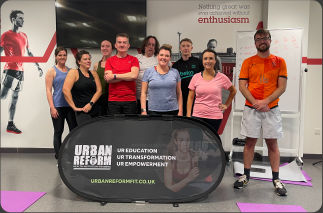Are you looking to improve your performance in strength training? Look no further than Urban Reform in Manchester!

As nutritional and exercise specialists with world-class facilities, Urban Reform has the expertise and resources to help you reach your strength training goals. Whether you’re a seasoned athlete looking to up your game or a beginner looking to get started, Urban Reform has something for everyone.
One of the key benefits of strength training is increased muscle strength. As you lift heavier weights over time, your muscles will adapt and become stronger, allowing you to perform everyday activities with ease and improve your athletic performance by generating more force. Strength training can also improve your power, endurance, mobility, and bone densiStrength training can help improve overall performance in a number of ways. Some potential benefits include:
Strength training can help improve overall performance in a number of ways. Some potential benefits include:
- Increased muscle strength: As you lift heavier weights over time, your muscles will adapt and become stronger. This can help you perform everyday activities with more ease and can also improve your athletic performance by allowing you to generate more force.
- Improved power: Power is a combination of strength and speed. By training with exercises that involve explosive movements, you can improve your power output, which can be beneficial for activities that require quick bursts of energy, such as sprinting or jumping.
- Enhanced endurance: Strength training can also improve your endurance by increasing the size and strength of your slow-twitch muscle fibers, which are responsible for sustaining activity over a long period of time.
- Better mobility: Strength training can help improve your range of motion and flexibility, which can make it easier to move and perform a variety of physical tasks.
- Improved bone density: Strength training can help increase bone density, which can reduce your risk of osteoporosis and other bone-related conditions.
What are the most effective exercises to increase strength?
There are many effective exercises that can help you improve your overall performance through strength training. Some examples include:
- Squats: Squats are a great exercise for building lower body strength and power. You can do squats with just your body weight, or you can use dumbbells, a barbell, or a kettlebell to add resistance.
- Deadlifts: Deadlifts are another excellent exercise for building strength and power in your lower body and back. They can be done with a barbell or dumbbells.
- Bench press: The bench press is a classic exercise for building upper body strength, specifically in the chest, shoulders, and triceps. You can use a barbell or dumbbells to do this exercise.
- Pull-ups: Pull-ups are a great exercise for building upper body strength, particularly in the back and biceps. You can use a pull-up bar or a resistance band to do this exercise.
- Lunges: Lunges are a good exercise for building lower body strength and improving balance. You can do them with just your body weight or you can hold dumbbells or a barbell to add resistance.
- Push-ups: Push-ups are a classic bodyweight exercise that can help build upper body strength, particularly in the chest, shoulders, and triceps.
- Planks: Planks are a good exercise for building core strength and stability. They can be done with just your body weight, or you can add resistance by using a resistance band or holding a weight.

Important points to consider when creating your plan
- Determine your goals: What are you hoping to achieve through exercise? Do you want to improve your strength, endurance, flexibility, or overall fitness? Setting specific, measurable goals can help you stay motivated and track your progress.
- Consider your current fitness level: It’s important to start at a level that is appropriate for your current fitness level. If you are new to exercise, you may want to start with low-impact activities such as walking or swimming, and gradually build up to more intense activities as you become more comfortable and confident.
- Incorporate a variety of activities: To get the most benefits from exercise, it’s important to incorporate a variety of activities into your plan. This might include strength training, cardiovascular exercise, flexibility training, and activities that you enjoy such as sports or dance.
- Gradually increase intensity and duration: As you become more fit, you can gradually increase the intensity and duration of your workouts to continue improving your fitness level.
- Allow for rest and recovery: It’s important to allow for rest and recovery between workouts to give your body time to repair and adapt. Aim to include at least one or two rest days in your weekly exercise plan.
- Consult with a professional: If you have any medical conditions or injuries, or if you are not sure how to get started with exercise, it may be helpful to consult with a healthcare provider or a certified personal trainer. They can help you create a safe and effective exercise plan that meets your needs and goals.
AN EXAMPLE PLAN FOR AN 80KG INDIVIDUAL LOOKING TO GET STRONGER AND QUICKER IN 2 MONTHS:
Week 1:
Monday: Full body strength training circuit (3 sets of 8-12 reps per exercise)
- Squats
- Lunges
- Push-ups
- Bench press
- Lat pulldowns
- Bicep curls
- Tricep dips
- Planks
Wednesday: Cardio interval training (30 seconds high intensity, 30 seconds low intensity)
- Treadmill sprints
- Jumping jacks
- Mountain climbers
- Box jumps
Friday: Full body strength training circuit (3 sets of 8-12 reps per exercise)
- Deadlifts
- Lunges with dumbbells
- Pull-ups
- Shoulder press
- Leg press
- Calf raises
- Russian twists
Week 2:
Monday: Cardio interval training (45 seconds high intensity, 15 seconds low intensity)
- Bike sprints
- Burpees
- Jump squats
- High knees
Wednesday: Full body strength training circuit (3 sets of 8-12 reps per exercise)
- Squats with dumbbells
- Step-ups
- Push-ups with dumbbells
- Bench press with dumbbells
- Row with dumbbells
- Leg press
- Bicep curls with dumbbells
- Tricep dips with dumbbells
Friday: Cardio interval training (30 seconds high intensity, 30 seconds low intensity)
- Elliptical sprints
- Skipping
- Plank jacks
- Lunges with a twist
This is just a sample plan and can be modified based on your specific goals and fitness level. It’s important to gradually increase the intensity and duration of the workouts as you becomes more comfortable and confident.
It’s also important to allow for rest and recovery between workouts to give the body time to repair and adapt. If your mate has any medical conditions or injuries, or if they are not sure how to get started with exercise, it may be helpful to consult with a healthcare provider or a certified personal trainer. They can help create a safe and effective exercise plan that meets your mate’s needs and goals.
It’s important to vary your workouts and include a mix of exercises that target different muscle groups. A certified personal trainer or a sports medicine professional can help you develop a safe and effective strength training program that meets your specific goals.
Nutrition support
Here is a sample nutrition plan for an individual who wants to lose weight in 6 weeks:
- Calculate your daily calorie needs: To lose weight, you need to create a calorie deficit by consuming fewer calories than you burn. Your specific calorie needs will depend on factors such as your age, sex, weight, height, and activity level. A general rule of thumb is to aim for a calorie deficit of 500-750 calories per day to lose about 0.5-1 pound per week.
- Focus on whole, unprocessed foods: Choose a variety of whole, unprocessed foods such as fruits, vegetables, whole grains, lean protein sources, and healthy fats. These foods are generally lower in calories and higher in nutrients, and can help you feel full and satisfied.
- Incorporate protein at every meal: Protein can help you feel full and satisfied, and can also help preserve muscle mass during weight loss. Aim to include a source of protein at every meal and snack, such as meat, poultry, fish, eggs, dairy, beans, or nuts.
- Limit added sugars and refined grains: Foods and beverages that are high in added sugars and refined grains are often high in calories and low in nutrients. Limiting these foods can help reduce your calorie intake and improve your overall nutrition.
- Drink plenty of water: Proper hydration is important for weight loss and overall health. Aim to drink at least 8 cups (64 ounces) of water per day, and more if you are active or live in a hot climate.
- Eat regular meals: Eating regular, balanced meals can help you feel full and satisfied and can also help regulate your blood sugar levels. Aim to eat every 3-4 hours throughout the day.
- Keep track of your progress: Keep track of your progress by tracking your food intake and physical activity in a food and activity journal or using a smartphone app. This can help you stay motivated and make any necessary adjustments to your plan.
It’s important to note that weight loss is not always a linear process, and it’s normal to experience ups and downs along the way. If you have any specific nutrition goals or needs, it may be helpful to work with a registered dietitian who can help you create a personalized nutrition plan.
Take your strength training to the next level
To get the most out of your strength training, it’s important to use proper form and gradually increase the intensity of your workouts. You should also aim to train all of the major muscle groups, including your chest, back, shoulders, arms, legs, and core. A certified personal trainer or a sports medicine professional can help you develop a safe and effective strength training program.
At Urban Reform, our team of certified personal trainers and sports medicine professionals will work with you to create a safe and effective strength training program tailored to your specific needs and goals. We offer a range of equipment and techniques, including free weights, machines, bodyweight exercises, and more.
But it’s not just about the workouts at Urban Reform. We also offer nutrition coaching to help you fuel your body for optimal performance. Our team of registered dietitians will help you create a nourishing meal plan that supports your training and helps you reach your weight loss or muscle building goals.
So why wait? If you’re ready to take your strength training to the next level, contact Urban Reform today and start your journey to improved performance and overall health. Don’t miss out on the opportunity to train with the best in the business – contact us asap to get started!
